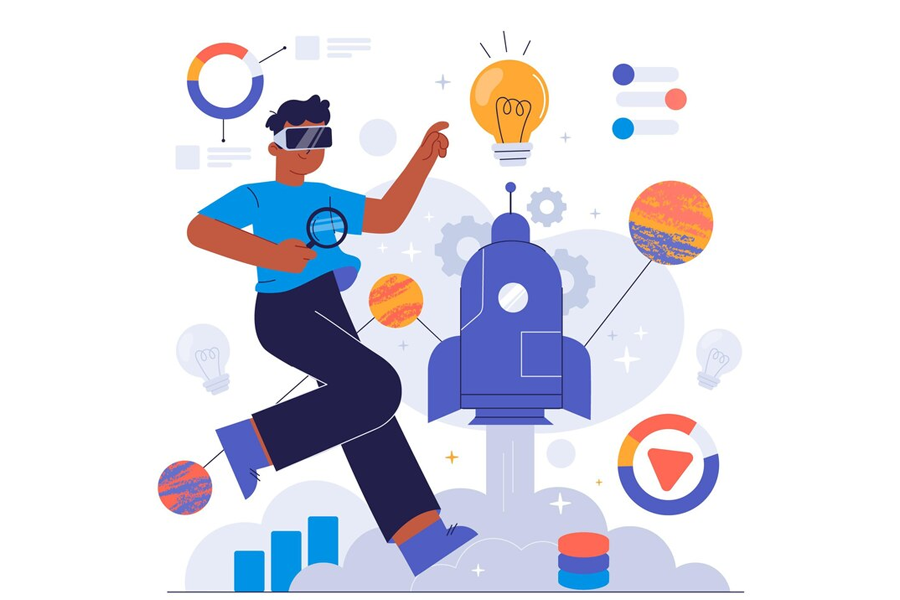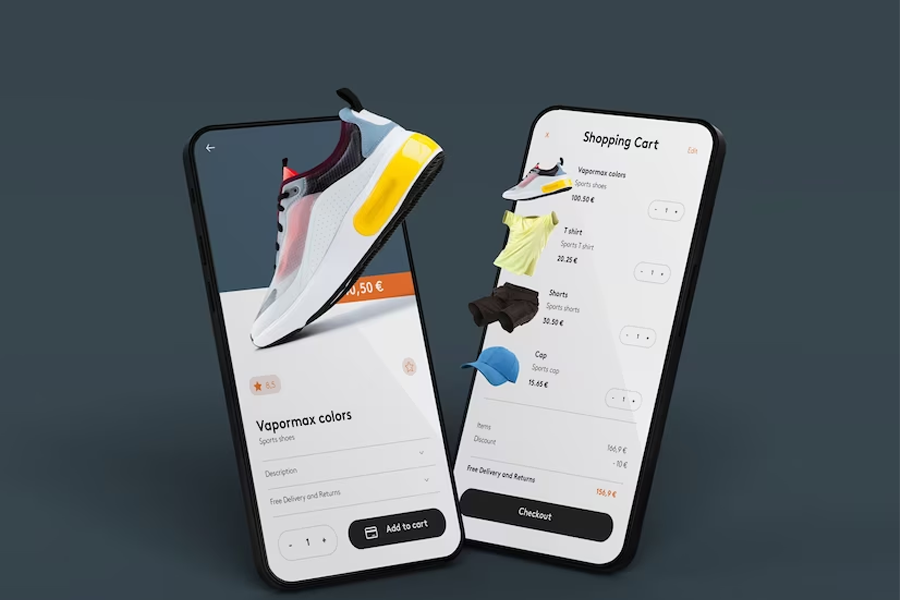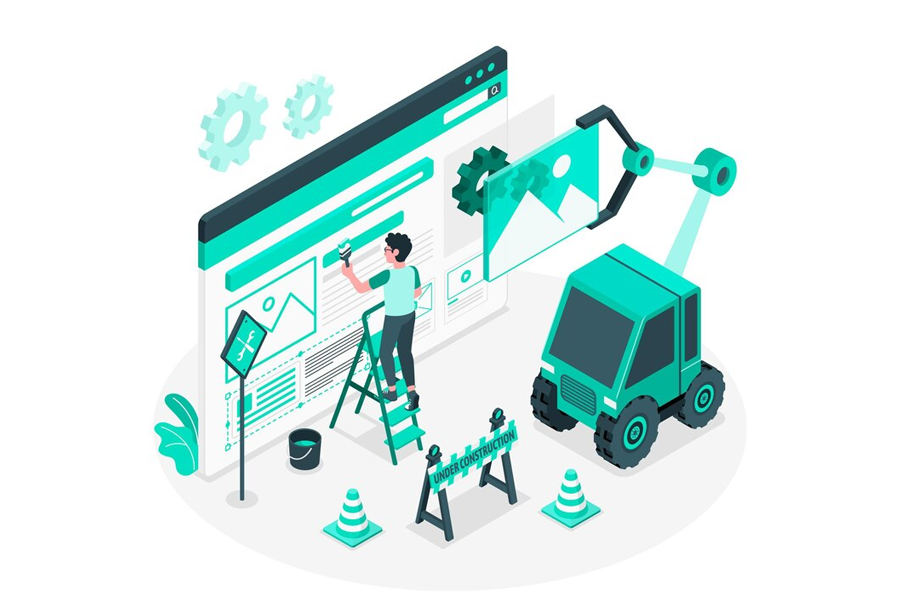Ten years ago, artificial intelligence was merely the stuff of novels and TV. But today, business owners like you use cutting-edge AIs to build their e-commerce websites.
Artificial intelligence is just one of the many trends in website-building platforms, with the potential to change everything.
You must be aware of the web design’s power, as an online business. Not only is the industry inherently dynamic, but more and more, website builders are shaping your online presence in ways previously not thought of.
Learning these trends could be what you need to outsmart the market.
In the paragraphs below, you will find the most important trends to watch out for this year and beyond.

17 Most Important Website-Building Platform Trends These 2024
Website-building platforms are critical for e-commerce businesses like yours. Without them, creating a website will remain a time-consuming and resource-intensive process, and only the businesses with the deepest pockets can enjoy the benefits of the Internet.
As it stands, website-building platforms allow businesses of any size to carve their own space in the online world with their own website and custom domain. These pages, after all, are one of the first things customers look for when researching a business.
Thus, you must keep abreast of all the important things happening among site builders. In this section, we’ll look at how website building is improved, faster, and more efficient.
#1 Artificial Intelligence (AI) and Machine Learning (ML)
Artificial Intelligence (AI) and Machine Learning (ML) are transforming the way that e-commerce businesses are creating and managing websites.
One of the best ways website builders use AI is personalization. AI algorithms analyze user behavior and preferences to tailor product recommendations, improving customer loyalty and sales.
Further, it’s also powering cutting-edge technologies like real-time dynamic pricing. AI tools built into the best website builders can adjust prices based on market conditions, competitor prices, and manufacturing costs. This can ensure competitive pricing at all times.
Aside from that, AI and ML tools also power technologies like visual search, supply chain optimization, fraud detection, automated customer support, and e-commerce-related generative AI.
Other website builders already utilize premium features that involve AI and ML. These technologies are not only improving e-commerce websites but also future-proofing businesses by providing a competitive advantage.
Nevertheless, it is essential to implement AI responsibly, especially in terms of user privacy and data protection.
#2 Augmented Reality (AR) and Virtual Reality (VR) integrations
AR and VR provide customers with immersive and interactive shopping experiences never seen in e-commerce.
These technologies are helping to close the gap between the online and physical shopping experiences, providing customers with more information about products and increasing their confidence in purchasing decisions – all fully online.
AR can be used to provide 3D views of products and show what a product would look like in a customer’s space. These are used in technologies like Sephora’s virtual try-ons for fashion and makeup, IKEA’s preview placements for furniture, and body-measurement apps.
Meanwhile, VR can create fully immersive experiences that transport customers to virtual worlds that fully showcase the product’s strengths. The potential of this technology for e-commerce is revealed in technologies like the Apple Vision Pro, which boasts live events, interactive ad campaigns, and interactive education.
AR and VR can help businesses create personalized, engaging, and memorable experiences that captivate customers and drive success. Nevertheless, remember that these technologies require significant investment in specialized knowledge and equipment to implement.

#3 Advanced customization options
Customization options in e-commerce website-building are evolving to meet the growing demands of businesses and customers.
Key trends include the following:
- Dynamic animation effects. Website builders increasingly enable users to apply dynamic effects to elements on their websites to improve interest and capture attention.
- Personalized product options. There are platforms that allow merchants to personalize products by setting up various customizable options, such as configuring product variants or integrating product customization apps.
- Customizable checkout processes. E-commerce platforms provide tools to customize checkout pages, improving the user experience.
- SEO-friendly tools. SEO-friendly tools are now being built into the website-building experience to improve website visibility. It makes search engine optimization efforts easier and more accessible for businesses regardless of their size.
- Integrated ecommerce functionality. Most builders offer a wide range of customizable e-commerce features, such as product pages, shipping options, and payment gateways according to their needs.
These customization options enable businesses to create unique and personalized online stores, improving the user experience and driving sales. When implementing, consider your business, its goals, and whether or not the customization options will help you meet them or just waste time and money.
#4 Intuitive drag-and-drop interfaces
Drag-and-drop editors simplify the website creation process and eliminate the need for coding knowledge. Some of the best free website builders have drag-and-drop interfaces. It makes websites much more accessible for all kinds of businesses.
A drag-and-drop editor is a type of website builder that gives customers complete control over the creation process even without prior experience.
The website building is streamlined – all you have to do is use the drag-and-drop interface to pick and implement the features you want. No coding is required. Most drag-and-drop website editors even provide pre-designed website templates.
These features allow beginners to quickly build their websites without any coding knowledge whatsoever.
Some top website builders easily let you implement advanced features like the following:
- Customizable templates;
- Brand-friendly color schemes;
- Text editing options;
- Contact forms;
- Social media integration;
- E-commerce capabilities.
These features enable anyone to create a unique and personalized online store. They’re especially valuable for beginners, small business owners, or one-person businesses who want to create websites without coding.
#5 Increased focus on website speed and performance optimization
According to a Google study, a one to three-second delay in page load time increases the probability of a bounce by 32%. This rises to 90% in a one to five-second delay. Slow-loading websites increase bounce rates, lower engagement, and decrease conversions.
To address this, website builders are implementing various technologies. Media optimization tools, Google’s PageSpeed Insights, and WebAssembly are used to improve website speed and performance.
E-commerce businesses improve their online presence by optimizing website speed and performance. Website builders are realizing that and are implementing their solutions.

#6 Integration with popular content management systems (CMS)
The integration with a popular content management system (CMS) simplifies website creation and makes content management easier.
CMS platforms offer a range of features and customization options and are widely used.
By integrating with a CMS, businesses can achieve the following:
- Save time and money;
- Improve SEO and user experience;
- Expand functionality and features;
- Empower their team and collaborators;
- Integrate with other tools and services (such as marketing and SEO tools, blogging tools, web plugins, and other handy extensions).
Managing critical content components of your website, like editors and SEO tools from the website builder platform ecosystem, can do a lot for business growth. It will make running online stores and other e-commerce features much easier for everyone involved.
#7 Greater emphasis on website security and data privacy
E-commerce websites are paying more attention to their security because of the increasing number of cyber threats and data breaches.
Here are a couple of examples:
- Microsoft (2023): Hackers accessed the email accounts of 25 organizations, including government agencies. The financial impact and affected user count are still being assessed.
- Capital One (2019): This breach impacted over 106 million people. Names, Social Security numbers, and credit card information were compromised. It cost Capital One around $190 million.
- Facebook (2019): This incident exposed millions of user data through third-party apps. The financial impact is difficult to quantify, but the reputational damage was significant.
To address this, website builder platforms are implementing various technologies. Features such as SSL certificates, two-factor authentication, and vulnerability scanning tools are being baked into the creation process to improve website security and data privacy.
Businesses protect their customers’ personal information by focusing on security and privacy. This builds trust and nurtures loyalty. Most importantly, it helps them avoid ruinous data breaches.
#8 Advanced mobile website building features and mobile-first design
The importance of mobile access for e-commerce cannot be denied.
Mobile devices contribute to approximately half of the overall web traffic. The number of mobile users has even surpassed desktop users. Global mobile e-commerce was worth $2.2 trillion last 2023.
Mobile-first design involves creating websites and applications with a primary focus on the mobile experience. It ensures that the core content and essential functionalities are best presented on mobile devices.
Website builders are implementing various technologies to optimize the mobile user experience. Features like flexible grid layouts, touch-friendly interfaces, and minimalist and clean design.
The mobile-first design also simplifies user interactions to work with touchscreens. It optimizes images and media to reduce file sizes and considers touch gestures like swipes and pinches that are common on mobile devices.
Mobile is already the frontline of e-commerce. If your business is not focusing on it, you’re already way behind on the trend. Fortunately, being a bit more optimized with mobile features and design will soon be much easier to implement.

#9 Marketing automation
Marketing automation tools can handle routine digital marketing tasks, such as email campaigns, social media management, and lead generation. This frees up time for businesses to focus on other important tasks.
Website-building platforms are implementing various technologies to improve marketing automation capabilities. Some of them are email automation tools, chatbots, and predictive AI.
For example, Sephora successfully utilized automation to personalize its customer experience.
They segment customers based on purchase history and preferences, triggering targeted email campaigns with relevant product recommendations. This resulted in a 13% increase in revenue per email.
Automation can be a powerful tool if implemented in your funnel correctly. Look into processes and systems that can be automated and find the most fitting solution for your needs.
#10 Customer relationship management (CRM) systems
CRM integration is a key trend to watch out for in website-building platforms. By integrating customer relationship management systems (CRMs) in their e-commerce websites, businesses upgrade customer experience.
Currently, there are five ways in which an ecommerce website can integrate with a CMS:
- Developing a CRM-based website;
- Linking the platform to a website through API integration;
- Connecting CRM to a website with a plugin or extension;
- Integrating with a website using webhooks;
- Connecting the CRM to a website through third-party integrations.
CRMs gather data and manage customer experiences at the same time, making the entire business-customer relationship function smoother.
A good CMS-CRM integration will funnel all activity on a website straight into a CRM for instant analysis, reporting, and actionable insights. All without the hassle typically associated with harvesting and utilizing data.
#11 Collaborative website building and project management features
A single person can create a website or switch templates. But making a bespoke, enterprise-level solution is a difficult affair, often requiring coordination between various departments, specialized knowledge and roles, and complex oversight.
Not to mention, companies are often outsourcing many of these processes.
The need for remote collaboration and efficient project management in website building is fueling the development of project management features in website building.
Website building project management – supported by the right software – can keep things running smoothly.
Website project management breaks down the various requirements of internal and external team members into specific tasks. They are then tackled collaboratively. Some of the best collaboration tools for web developers include Monday.com, Trello, Wrike, and Smartsheet.
#12 The rise of headless website-building platforms
Headless CMS platforms are a modern approach to web development.
When making websites, the “head” is often used to refer to the front end – the part of the website that audiences see and interact with. The “body” is the back-end, where all the data and complex codes are stored.
Headless website-building platforms are simply platforms that separate front-end development from the back-end.
This separation gives web designers and web developers unparalleled flexibility and creativity. Each component is prepared independently, and you can mix and match them however you want. Drag-and-drop website builders are an example of headless website-building platforms.
Without this separation, anyone wanting to make a website will need to learn how to create both the front and back end.
With a headless platform, you can build and update the head (front-end) and body (back-end) separately.
With a headless approach, you can update the look and feel of their website quickly. You can create a more personalized and tailored user experience, easily adapt content and functionality for various platforms, and manage content more effectively.
Headless website-building platforms are projected to reach a staggering $2879.4 million by 2030, fueled by the consumer’s need for flexibility and personalized experiences.
#13 Voice search and natural language processing
According to Statista, voice search made $4.6 billion in global e-commerce sales last 2021. That’s not even the most impressive part: that number rose to $19.4 billion by 2023 – a meteoric 400+% growth in just two years.
Voice search offers a hands-free, time-efficient alternative to typing. Your customers can do it while they’re walking, doing chores, or something else. Voice-driven interfaces also reach a broader audience – specifically individuals with disabilities.
As voice-enabled devices like smart speakers and virtual assistants grow in popularity, businesses like yours must adapt to this shift in user behavior.
To address the trend of voice search and natural language processing, web developers are implementing the following technologies:
- Advanced Natural Language Processing (NLP) algorithms to understand and interpret human language;
- Automatic Speech Recognition (ASR) to transcribe spoken words into text;
- Schema markup and structured data to help search engines better understand and categorize content.
These technologies enable businesses to tailor their content and website design to meet the needs of voice-search users. As an advantage, it improves their online visibility and lets them engage with more audiences.

#14 Integrations with social media and influencer marketing
As users increasingly turn to social platforms for information and recommendations, website builders are adapting to this shift for a more interconnected online experience.
Influencer marketing, specifically, is taking center stage.
People trust their chosen influencers, and they are willing to buy what their influencers buy. When ads receive an influencer marketing integration, they build up more power on social media.
Thus, social media widgets, live feeds, and sharing buttons are becoming a staple in many website builders. These buttons instantly take an audience to the relevant social platform, facilitating instant and seamless interaction between websites and social platforms.
#15 Cloud-based website building platforms
Most free website builders are hosted on the cloud, operating on Infrastructure as a Service (IaaS) principles.
Instead of investing in physical servers and maintaining a complex infrastructure, e-commerce businesses use cloud service providers’ resources.
Providers are the ones who maintain all the complex stuff. Users – from individual blogs to businesses like yours – just get to enjoy the output that they want.
Since your website is in the cloud, you can work on it from any device with an internet connection. It’s also very convenient; often, the platforms themselves take care of mission-critical steps like web hosting, updates, and backups for you.
On the other hand, all users need to do is pay a flat per-month fee or a per-month billed annual price. This would depend on the features they avail of. Most website builders even have a free plan or a free trial. You can try out features like a free domain, free hosting, or a free SSL certificate.
They make it easy for everyone, from beginners to small businesses with one-man teams, to create their websites.
#16 Gamification and interactive design elements
This trend is characterized by the integration of game-like features into non-game contexts to boost user engagement and retention. It involves implementing game-like elements on a webpage to engage the user.
Here are some examples:
- Point systems;
- Badges;
- Leaderboards;
- Achievements;
- Goals;
- Daily or weekly challenges;
- Rewards, and others.
When you see points being assigned to completing your profile, engaging with products/other users, or completing specific tasks, those are gamification elements.
The heart of gamification lies in tapping into the innate human drive for rewards. Your audience loves being pointed in a fun and specific direction. And they want to be rewarded. When you build a website, remember that gamifying features let you tailor content and website design to be more engaging to their target audience.
#17 Website accessibility and inclusivity
An estimated 15-20% of the world’s population lives with a disability of some kind, and the internet still is not kind to them. There is a push for interfaces to welcome and accommodate as many different users as possible, and website builders are seeing that.
For this, most website builders are embracing responsive design principles. This ensures that websites are adaptable to various devices, aiding users with diverse needs. Integration of voice interfaces, semantic HTML, and structured data is also becoming more normalized.
Even AI is being investigated for potential website accessibility implications. Things like automated testing and user experience enhancement can be easily implemented by these tools.
The trend toward website accessibility and inclusivity is becoming a modern imperative. Many are on board, with the hopes that this will shape the future of web development.
Final Thoughts
Website-building platforms are a fundamental part of e-commerce.
Learning the current trends dominating this industry is critical in informing you about market shifts that you should be wary of. These trends could be your boon, a competitive edge. On the other hand, misuse or lack of information could mean you will get left behind.
In this article, we tackled the most important trends and features that a website builder tool could have.
Use this as a guide to assess the best website builder for your online visibility strategy in 2024.

Frequently asked questions
What is the best free website builder?
The right website builder for your business can be difficult to generalize, as it would depend on your specific needs. If you want a small business website, free website builders might be enough. On the other hand, more specific needs like a custom domain name and web hosting services will likely require a professional website builder with paid subscriptions. Ultimately, the best ecommerce website builder is up to your research, whether free or paid.
What is a WordPress website?
The WordPress site builder is one of the most well-known content management systems (CMS around). WordPress websites are sites created only through the WordPress builder. This platform is flexible and extensible, and you can create a blog, membership site, or a home for your online shop.
How can I find the best ecommerce website builder for my needs?
You must plan properly when choosing the right builder tool for your business. Consider critical factors like your budget, whether or not you just need a website template or a custom website, advanced customization options, and customer support. The decision will depend on your needs, so make sure to evaluate properly.
How is Google Analytics improving website building?
Google Analytics is a powerful tool that can improve website building by providing valuable insights into user behavior, site performance, and areas that need improvement. You can use this tool to assess your e-commerce website, spot things to improve, and work on them for better performance.